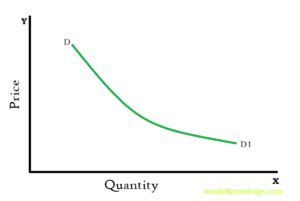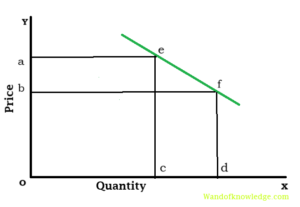Elasticity of Demand refers to “a measure of the degree to which the quantity purchased will respond to a change in any single variable is called its elasticity with respect to that variable.” Thus the measure of responsiveness of the quantity demanded of a good relative to a change in its price is called the price elasticity of demand for the good.
In other words the price elasticity of demand is a measure of the responsiveness of demand to price changes; it measures the curvature of the demand curve. In other words, it quantifies how consumption responds to changes in price, i.e. by how much consumption will change as a result of change in price.
Since demand changes due to changes in income as well, response of demand to price changes is called the price elasticity of demand and response of demand to income changes as income elasticity of demand. However, the expression elasticity of demand is always understood to refer to the price elasticity of demand.
Definitions
It can be defined as follows-
- “The proportional change in the quantity purchased is divided by the proportional change in price.” –Hirshleifer and Glazer.
- “The percentage change in the quantity demanded divided by the percentage change in price that brought it about.” –Llpsey and Chrystal
- “The price elasticity of demand (sometimes simply called ‘price elasticity’) measures how much the quantity demanded of a good change when its price changes. The precise definition of the price elasticity is the percentage change in quantity demanded divided by the percentage change in price.” –Samuelson and Nordhaus
- “The elasticity (or, responsiveness) of demand in a market is great or small according as the amount demanded increases much or little for a given fall in price, and diminishes much or little for a given rise in price. –Alfred Marshall
Degrees of elasticity of demand
There are five different possible degrees of the relationships between and the corresponding change in quantity demand of a commodity.
-
Unit Elasticity –
The change in demand is exactly equal to change in price as q = p. Say the percentage change in both is 5% then-
=[Relative change in quantity] / [Relative change in Price] = 5% / 5% = 1
-
High Elasticity –
It is also known as more than unity. The change in quantity demanded is more than change in price.
-
Perfectly Elastic-
It refers to the situation where slight change in price of a commodity causes an infinite change in the quantity demand of a commodity. The demand in such cases is hyper sensitive and the elasticity of demand is infinite.
-
Low Elasticity –
It is also termed as less then unity. The change in demand is less then unity. The change in demand is less then change in price.
-
Zero Elasticity –
In this degree, there is no change in demand and only the price changes.
Measurement of Price of Demand Elasticity
Economists have used various methods to measure the price elasticity of demand. The following can be mentioned briefly:
-
Total outlay (Revenue) Method-
This method to measure the elasticity of demand was used by Prof. Marshall. In this method we compare the change in the total expenditure incurred by a consumer (also called total outlay) before and after; the variation in price. Elasticity of demand” is expressed in three ways: (i) unity; (ii) greater than unity and (iii) less than unity.
-
Unity (E=1)-
Elasticity of demand is considered, unity when the total expenditure remains the same whatever be the price. With a change in price the quantity demand changes in such a way that the total outlays remains the same. Table shows that the total expenditure of a consumer is the same at all levels of prices. As shown in figure a demand curve with unit elasticity is called a rectangular hyperbola. This curve shows that the total expenditure remains constant on all points of the curve.

| Price Rs. | Demand Units | Total Outlays Rs. |
| 10 | 10 | 100 |
| 5 | 20 | 100 |
| 2 | 50 | 100 |
| 1 | 100 | 100 |
-
Greater than Unity (E >1):
The elasticity of demand is said to be greater than unity when with a fall in y price, the expenditure increases or as the price increases the expenditure falls. In Table the total, expenditure or total outlay increases as the price falls and the demand increases. When the elasticity of k.” demand is greater than unity, percentage change demand is more than percentage change in price. In Table the price has Quantity become one-half (from Rs. 10 to Rs.5) but Fig. the demand has increased fourfold (from 1 to 4). As shown in figure a demand curve with elasticity greater than unity in relatively flat. The rectangle ODEF is larger than rectangle OABE. It shows that if the price falls by EF demand increases in such a way (by AF) that the total expenditure increases.

| Price Rs. | Demand Units | Total Outlays Rs. |
| 10 | 1 | 10 |
| 8 | 2 | 16 |
| 5 | 4 | 20 |
| 4 | 6 | 24 |
-
Elasticity less than Unity (E<1) :
Elasticity between two prices is considered to be less than unity when the total amount spent increases with a rise in price and decreases which a fall in price. In Table the total expenditure is decreasing as the price falls and increases as the price increases. So there is direct relationship Quantity between change in price and total expenditure. Such demand is called inelastic and the demand curve is steep. It shows that change in amount demanded is less than the change in price.
| Price Rs. | Demand Units | Total Outlays Rs. |
| 10 | 20 | 200 |
| 5 | 30 | 150 |
| 1 | 40 | 40 |
-
Perfectly Inelastic demand (E=0):
A demand is called perfectly inelastic when change in price does not affect the quantity demanded at all. The demand is fixed for all the prices. The result is that because of a fall in price there is a proportional fall in the total expenditure. As in figure the demand curve is parallel to axis Y. It is a vertical line.
-
Perfectly Elastic Demand (E=):
In Y the case of commodity having a perfectly elastic demand even as light increase in the price leads the consumer to totally stop the purchases. The elasticity in this case is infinite and the demand curve is parallel to the X-axis, as in figure. In this figure demand is zero for all prices above OD, but at price OD demand is infinite.
-
Percentage Method:
While calculating elasticity of demand with the help percentage method we compare percentage change in quantity demanded to percentage change in the price. The elasticity according to this method is the percentage change in the quantity demanded to the percentage change in the price. Thus the price elasticity becomes the ratio of a relative change in quantity demanded to a relative change in price.
If E stands for elasticity, then
E= Relative change in quantity / Relative change in price
Relative change in quantity demanded can be measured by dividing change in quantity demanded by the amount demand or
Relative change in demand = Change in quantity demanded / amount demanded
Similarly relative change in price can be measured by dividing change in price by the original price, or
Relative change in price,
E= ΔQ/Q + ΔP/P = ΔQ/Q × P/ΔP = P/Q × ΔP/ΔQ
Here Q is quantity, P is price, (delta) is the symbol meaning “a change in”. Thus ΔQ/Q is relative change in demand and ΔP/P is relative change in demand and is relative change in price.
-
Graphical Method –
In this method a point is picked up on curve and a draw a tangent to find the ep.
Substitution Elasticity- One of the most important determinants of elasticity of demand for a commodity is the availability of its closed substitute. The higher the degree of the closeness of the substitute, the greater the elasticity of demand for the commodity for instance coffee & tea may be considered as close substitutes of each other. If the price of coffee rises, we may curtail its purchase and take to tea or vice-versa. This is known as Substitution Elasticity.
You may also like
- Law of Diminishing Marginal Utility
- Significance of Business Economics in Decision Making
- Demand and Demand Curve- Explanation & Exception
- Circumstances in which Demand Curve Slopes Upward
- Law of Demand- Definition, Chief Characteristics
- Importance of the Law of Diminishing Marginal Utility
Disclaimer: wandofknowledge.com is created only for the purpose of education and knowledge. For any queries, disclaimer is requested to kindly contact us. We assure you we will do our best. We do not support piracy. If in any way it violates the law or there is any problem, please mail us on wandofknowledge539@gmail.com
